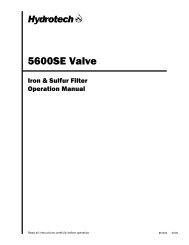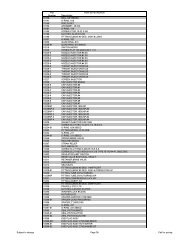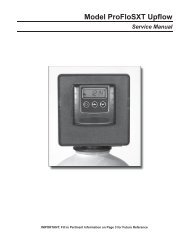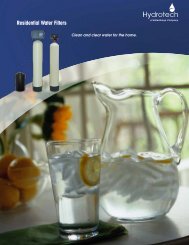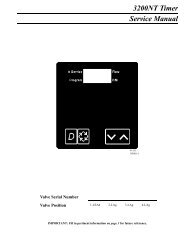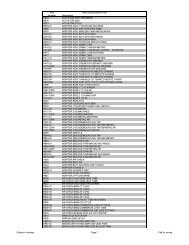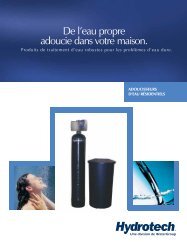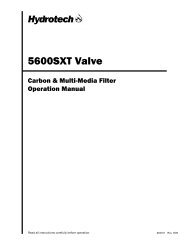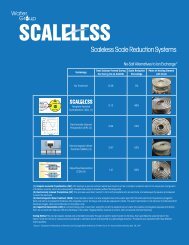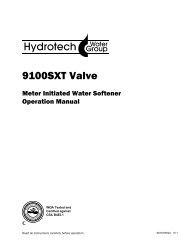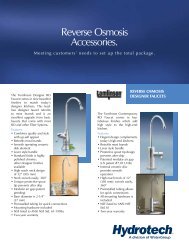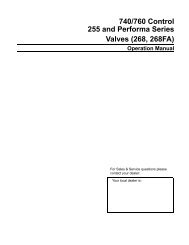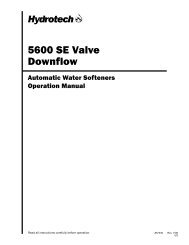HY US 01 Introduction.qxp - Hydrotech
HY US 01 Introduction.qxp - Hydrotech
HY US 01 Introduction.qxp - Hydrotech
Create successful ePaper yourself
Turn your PDF publications into a flip-book with our unique Google optimized e-Paper software.
GreensandPlus<br />
General Notes<br />
pH<br />
Raw waters having natural pH of 6.2 or above can be<br />
filtered through GreensandPlus without pH<br />
correction. Raw waters with a pH lower than 6.2<br />
should be pH-corrected to 6.5-6.8 before filtration.<br />
Additional alkali should be added following the filters<br />
if a pH higher than 6.5-6.8 is desired in the treated<br />
water. This prevents the possible adverse reaction<br />
and formation of a colloidal precipitate that<br />
sometimes occurs with iron and alkali at a pH above<br />
6.8.<br />
Removing Fines and Initial Conditioning<br />
Prior to placing the anthracite in the filter or placing<br />
the filter into service, GreensandPlus should be<br />
thoroughly backwashed and the top layer of fine<br />
material removed by undercutting in accordance with<br />
AWWA B 100, paragraph 4.5.2. This is especially<br />
important if anthracite is placed on top of the<br />
GreensandPlus bed. Each cubic foot of<br />
GreensandPlus shipped contains sufficient material<br />
to compensate for the removal of this final material.<br />
GreensandPlus is NOT shipped in a regenerated<br />
form; therefore it is necessary, prior to use, to<br />
regenerate it with a solution of potassium<br />
permanganate contacting the bed for a minimum of 4<br />
hours. A regeneration level of 4 ounces of KMn04 or<br />
chlorine per cubic foot of GreensandPlus is<br />
recommended. Before placing into service, the filter<br />
must be rinsed of all remaining traces of potassium<br />
permanganate.<br />
Methods of Operation<br />
Continuous Regeneration (CR)<br />
Continuous regeneration (CR) operation is<br />
recommended in applications where iron removal is<br />
the main objective in well waters with or without the<br />
presence of manganese. This method involves the<br />
feeding of a predetermined amount of chlorine (CI2)<br />
and /or potassium permanganate (KMn04), directly to<br />
the raw water before the GreensandPlus Filter.<br />
Chlorine should be fed at least 10-20 seconds<br />
upstream of the KMn04, or as far upstream as<br />
possible to insure adequate contact time. KMn04, if<br />
required, should be fed to produce a “just pink” color<br />
in the filter inlet. This slight excess of KMn04 or a CI2<br />
residual carried through the filter will maintain<br />
GreensandPlus in a continuously regenerated<br />
condition.<br />
The dosage of CI2 and KMn04 may be estimated as<br />
follows:<br />
mg/L CI2 = mg/L Fe<br />
mg/L KMn04= (0.2 x mg/L Fe) + (2 x mg/LMn)<br />
Without CI2 the KMn04 demand may be estimated by:<br />
mg/L KMn04= (1 x mg/L Fe) + (2 x mg/L Mn)<br />
GreensandPlus: Continuous Regeneration (CR)<br />
Radium and Arsenic Removal Using<br />
GreensandPlus<br />
The GreensandPlus CR process has been found to<br />
be successful in removing radium and arsenic from<br />
well water. This occurs via adsorption onto the<br />
manganese and/or iron precipitates that are formed.<br />
For radium removal, soluble manganese must be<br />
present in or added to the raw water for removal to<br />
occur. Arsenic removal requires iron to be present in<br />
or added to the raw water to accomplish removal.<br />
Pilot plant testing is recommended in either case.<br />
Inversand<br />
Company<br />
<strong>Hydrotech</strong><br />
93



